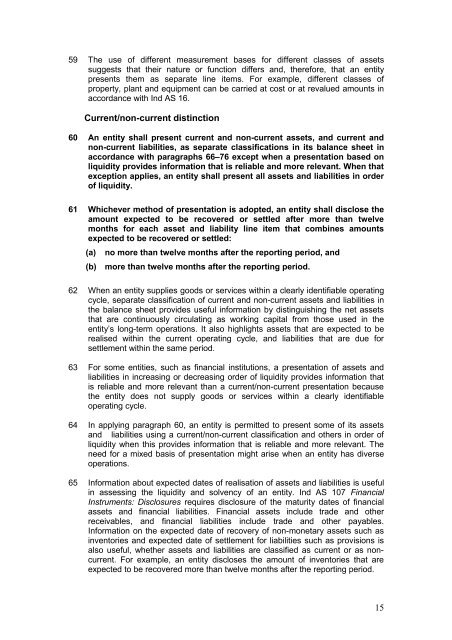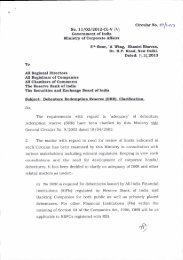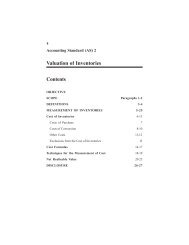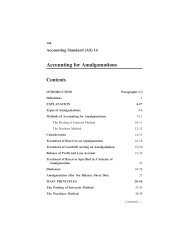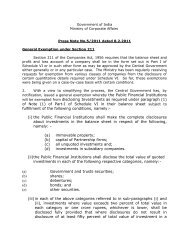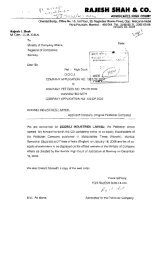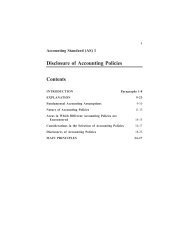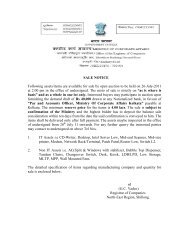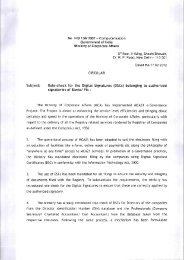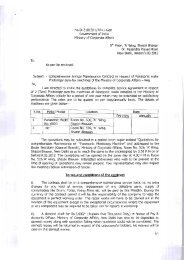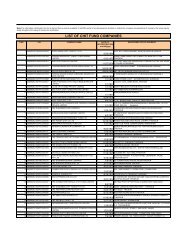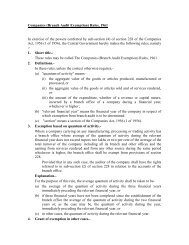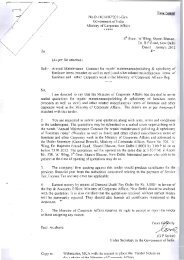Indian Accounting Standards(Ind AS) 1
Indian Accounting Standards(Ind AS) 1
Indian Accounting Standards(Ind AS) 1
Create successful ePaper yourself
Turn your PDF publications into a flip-book with our unique Google optimized e-Paper software.
59 The use of different measurement bases for different classes of assets<br />
suggests that their nature or function differs and, therefore, that an entity<br />
presents them as separate line items. For example, different classes of<br />
property, plant and equipment can be carried at cost or at revalued amounts in<br />
accordance with <strong>Ind</strong> <strong>AS</strong> 16.<br />
Current/non-current distinction<br />
60 An entity shall present current and non-current assets, and current and<br />
non-current liabilities, as separate classifications in its balance sheet in<br />
accordance with paragraphs 66–76 except when a presentation based on<br />
liquidity provides information that is reliable and more relevant. When that<br />
exception applies, an entity shall present all assets and liabilities in order<br />
of liquidity.<br />
61 Whichever method of presentation is adopted, an entity shall disclose the<br />
amount expected to be recovered or settled after more than twelve<br />
months for each asset and liability line item that combines amounts<br />
expected to be recovered or settled:<br />
(a) no more than twelve months after the reporting period, and<br />
(b) more than twelve months after the reporting period.<br />
62 When an entity supplies goods or services within a clearly identifiable operating<br />
cycle, separate classification of current and non-current assets and liabilities in<br />
the balance sheet provides useful information by distinguishing the net assets<br />
that are continuously circulating as working capital from those used in the<br />
entity’s long-term operations. It also highlights assets that are expected to be<br />
realised within the current operating cycle, and liabilities that are due for<br />
settlement within the same period.<br />
63 For some entities, such as financial institutions, a presentation of assets and<br />
liabilities in increasing or decreasing order of liquidity provides information that<br />
is reliable and more relevant than a current/non-current presentation because<br />
the entity does not supply goods or services within a clearly identifiable<br />
operating cycle.<br />
64 In applying paragraph 60, an entity is permitted to present some of its assets<br />
and liabilities using a current/non-current classification and others in order of<br />
liquidity when this provides information that is reliable and more relevant. The<br />
need for a mixed basis of presentation might arise when an entity has diverse<br />
operations.<br />
65 Information about expected dates of realisation of assets and liabilities is useful<br />
in assessing the liquidity and solvency of an entity. <strong>Ind</strong> <strong>AS</strong> 107 Financial<br />
Instruments: Disclosures requires disclosure of the maturity dates of financial<br />
assets and financial liabilities. Financial assets include trade and other<br />
receivables, and financial liabilities include trade and other payables.<br />
Information on the expected date of recovery of non-monetary assets such as<br />
inventories and expected date of settlement for liabilities such as provisions is<br />
also useful, whether assets and liabilities are classified as current or as noncurrent.<br />
For example, an entity discloses the amount of inventories that are<br />
expected to be recovered more than twelve months after the reporting period.<br />
15


